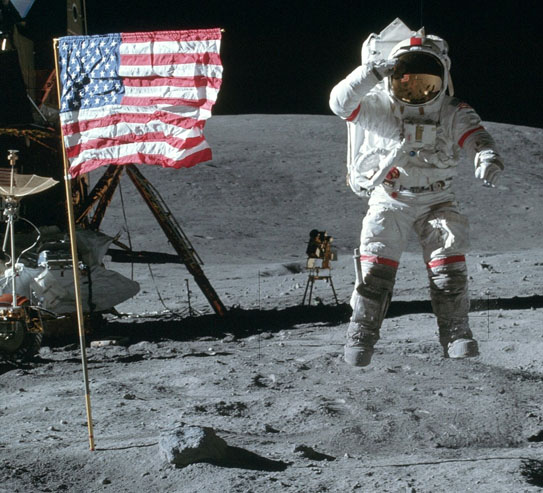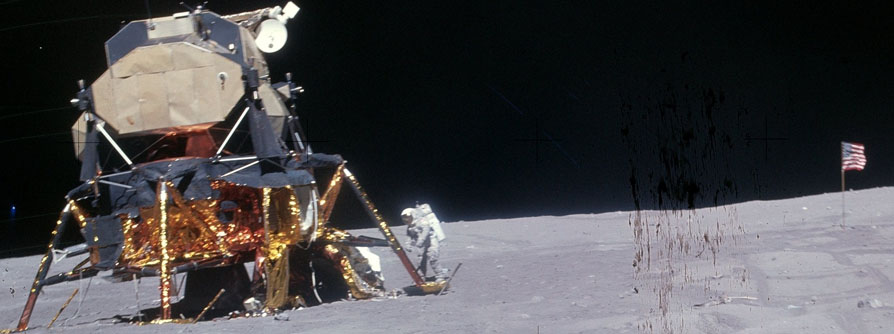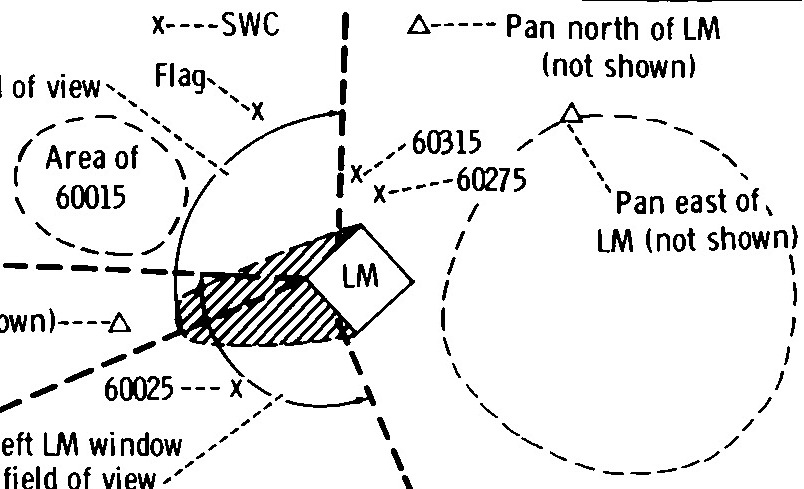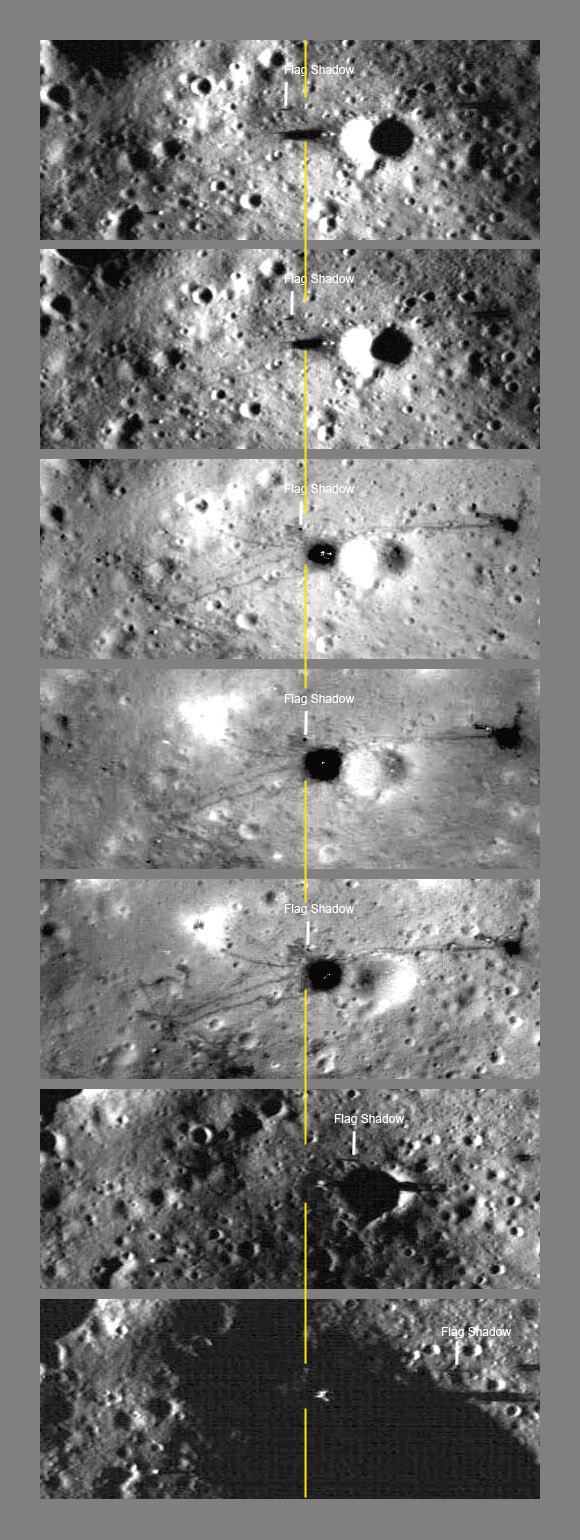
Apollo 16 Flag Still Aloft
Copyright © 2012 by Eric M. Jones
All rights reserved.
Last revised 21 April 2012.

| Animation
made from seven LROC images of the Apollo 16 landing site,
ordered from sunrise to sunset, and showing the changing
length and location of the shadow cast by the U.S. flag
erected by the crew. The frames are: (1) M116215545RC,
Sun 8 degrees above the eastern horizon; (2) M131548593RC,
10 deg. east; (3) M144524996LC,
43 deg. east; (4) M142164190RC,
69 deg. east; (5) M122108795LC
, 61 deg. west; (6) M117392541LC,
7 deg. west; and (7) M132732855RC,
2 deg. west. LROC images courtesy NASA/GSFC/Arizona State
University. |
The Apollo 16 moon landing occurred on April 21, 1972, with the crew
spending 71 hours on the lunar surface before returning to lunar
orbit. During that time, the U.S. flag was planted on the
surface. As indicated in an overall discussion of the six
flags left on the lunar surface, there are questions as to whether
the flag material disintegrated over time or whether any of the flag
poles had fallen, either during the Lunar Module liftoff or anytime
afterward). This article resolves this issue for Apollo 16.
The following three images show the Apollo 16 flag before and soon
after the Lunar Module ascent.

Detail from AS16-113-18339,
taken early in EVA-1. View to the south toward Stone
Mountain. The LM landed on level terrain but, beyond
25 meters from the spacecraft, slopes could be 6-10
degrees. The flag is pointing somewhat north of
west. Note
that John Young jumped about 0.42 meters off the
ground. (Click on the image for a larger version.)
|

Detail from AS16-116-18723,
taken by John Young on his way back to the LM from the
Rover's final parking place. The view is to the
west. The camera was tilted about 4-5 degrees to the
right when Young took the photo. It is possible that
Young took the photo with the camera handheld, almost
certainly at chest height. The spacecraft landed tilted
back to the east by 2.3 degrees and rolled left (south) by
0.4 degrees. (Click on the image for a larger version.)
|

Frame from the Rover TV taken
after LM liftoff. The TV camera is tilted to the
left by about 9 degrees because the Rover was parked about
50 meters east of the LM on uneven ground. Note that
the flag is pointing more to the north than it was in
Young's photo (above) and that the flagpole is tilted to
the right.
|
Based on a comparison of pre- and post-ascent images, the flag did
not fall, but the pole seems tilted by 30 degrees off the local
vertical. Since the rover took video from the East, the
orientation of the flag suggests it offers a shadow perpendicular
to the Sun’s rays at dusk and dawn. At LM liftoff (about
01:26 UTC on 24 April 1972, the Sun was at an azimuth of 77
degrees and an elevation of 50 degrees. Consequently, the
dark spot on the ground near the flag is the flag's shadow.
It seems unlikely that either the flag or the support rod that
runs along the top edge of the flag is touching the ground.
Rover TV images show the rest of the flag below this edge fairly
well which would not be the case if the top support rod was
touching the ground (the flag on the bottom edge would be bent and
crinkled). A TV frame
taken moments after John Young erected the flag shows its
condition at that time. Although no TV coverage is available
of the actual deployment, it is evident that Young pushed the
flagstaff into the ground by hand. He did not comment on the
depth of penetration. The Apollo 17 crew chose to hammer the
lower section of the flagstaff into the ground before fitting the
upper section. A comparison
between the Apollo 16 and 17 flags, as deployed, indicates that
the lower section of the Apollo 17 flagstaff (below the gray joint
section) is about 10-20 cm farther in the ground than the Apollo
16 flagstaff. Seeing the obvious tilt of the Apollo 16
flagstaff in the post-liftoff TV may have convinced the Apollo 17
crew that they should hammer in the lower section of theirs.
The following animation made from a detail from Figure 6-13 in the Apollo 16
Preliminary Science Report and a detail from an LROC image M142164190RC,
taken with the Sun only 31 degrees east of the zenith, shows the
layout of the site near the LM. North is up.

With the Sun near the zenith,
variations in surface brightness in the LROC image are
small. Contrast adjustments made to bring out
details makes the soil the astronauts disturbed around the
LM nearly black. The flag shadow northwest of the LM
is well defined. The crater immediately east of the
LM has a diameter of about 25 meters.
|
In the LROC animation and the
following figure, we are seeing the shadow of the flag, but not of
the flag pole. The flag pole is only 0.876 inches in diameter and
its shadow will be about the same. LRO cameras can at best see
down to 0.45 meters (1.5 feet) which is the equivalent to one
pixel width in the images and 0.55 meters (1.8 feet) which is
equivalent to one pixel of height. This resolution is good
enough to see the tilted flag’s shadow which, because the flag is
pointing north, is about 0.9 m (3 feet) across from north to
south. Importantly, clear separations of the entire shadow
from the flagpole locations before mid-morning and after
mid-afternoon (following figure) demonstrates that (1) we are
seeing shadows of the flag and not the pole; and (2) the flag is
not touching the surface.

This stack displays the seven
LROC images details used to make the animation at the top
of the page. The vertical yellow lines approximate
the east-west location of the flagpole. In the early
morning images at the top of the stack, the flag shadows
start from points west of the flagpole and end farther
west. The situation is reversed for the late
afternoon images at the bottom of the stack.
|
Flag assembly prior to
deployment. The upper part of the flagpole is at the
top, with the support rod for the top of the flag attached
by a latching hinge at the right. The bottom section
of the pole is below those two items. The portion of
the bottom section that is pushed or hammered into the
surface on on the right, with two short knurled sections
indicating how far the pole should be pushed in for
adequate stability.
|
The flag height depended upon how far
the pole could be placed into the regolith, which varied from
mission to mission. Assuming vertical deployment of a flat
surface, with the flagpole 87 inches from the ground to the top of
the pole and the bottom hem of the flag 50 inches above the
ground, for the near sunrise image (8 degree solar elevation), the
nearest part of the shadow would be 356 inches (9.0 meters) from
the flagpole and the farthest part would be 619 inches (15.7
meters) away.







